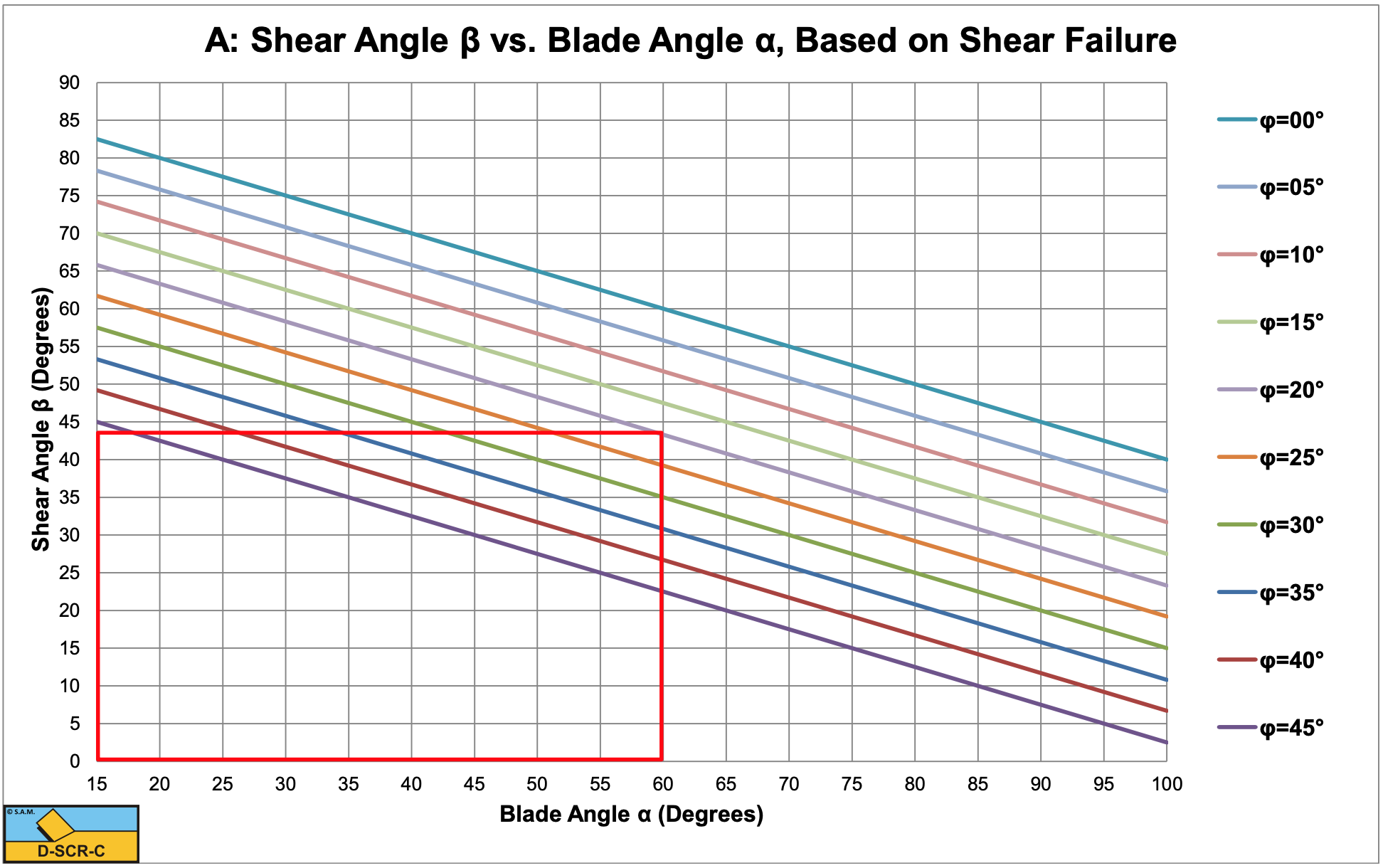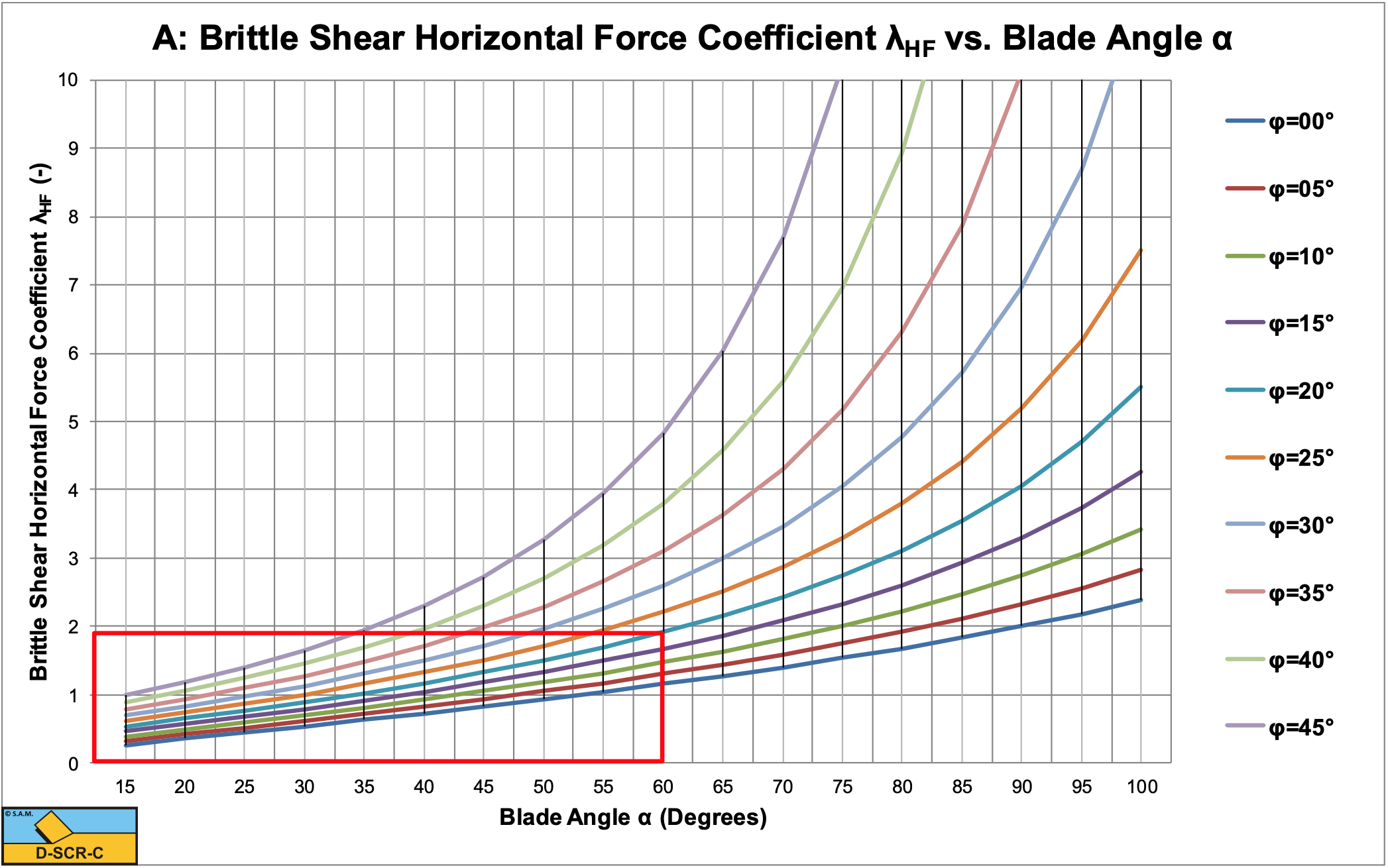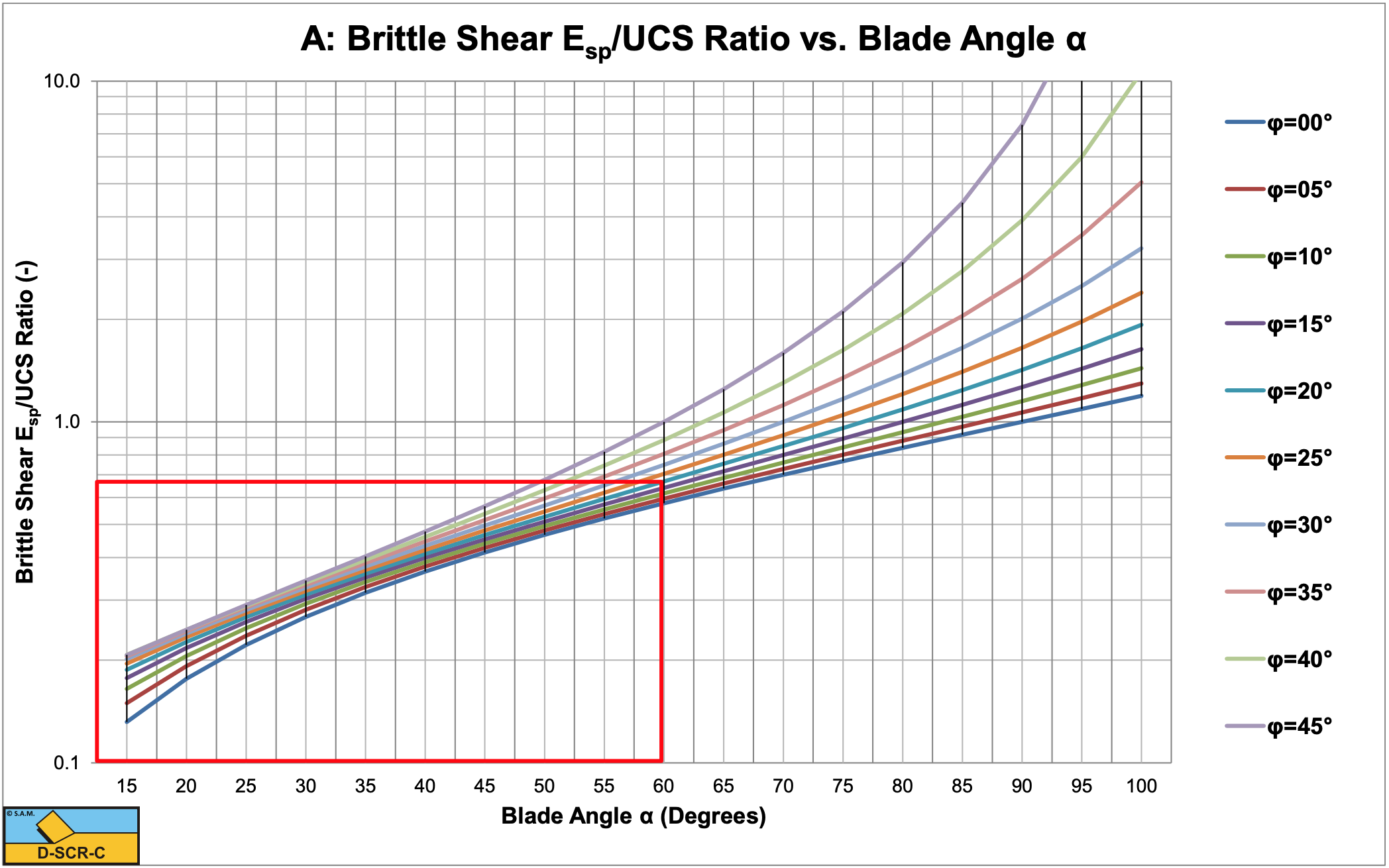8.5: Determining the Angle β
- Page ID
- 29468
To determine the shear angle β where the horizontal force Fh is at the minimum, the denominator of equation (8-105) has to be at a maximum. This will occur when the derivative of Fh with respect to β equals 0 and the second derivative is negative.
\[\ \frac{\partial \sin (\alpha+\beta+\delta+\varphi) \cdot \sin (\beta)}{\partial \beta}=\sin (\alpha+2 \cdot \beta+\delta+\varphi)=0\tag{8-107}\]
\[\ \beta=\frac{\pi}{2}-\frac{\alpha+\delta+\varphi}{2}\tag{8-108}\]
This gives for the cutting forces:
\[\ \mathrm{F_{h}=\frac{2 \cdot c \cdot h_{i} \cdot w \cdot \cos (\varphi) \cdot \sin (\alpha+\delta)}{1+\cos (\alpha+\delta+\varphi)}=\lambda_{H F} \cdot c \cdot h_{i} \cdot w}\tag{8-109}\]
\[\ \mathrm{F}_{v}=\mathrm{\frac{2 \cdot c \cdot h_{i} \cdot w \cdot \cos (\varphi) \cdot \cos (\alpha+\delta)}{1+\cos (\alpha+\delta+\varphi)}=\lambda_{V F} \cdot c \cdot h_{i} \cdot w}\tag{8-110}\]
Equations (8-109) and (8-110) are basically the same as the equations found by Merchant (1944), (1945A) and (1945B). The normal force N1 and the normal stress σN1 on the shear plane are now (with λs=1):
\[\ \begin{array}{left}\mathrm{N}_{1}=\frac{-\mathrm{C} \cdot \cos (\alpha+\beta+\delta)}{\sin (\alpha+\beta+\delta+\varphi)} \cdot \cos (\varphi)\\
\sigma_{\mathrm{N} 1}=\frac{-\mathrm{c} \cdot \cos (\alpha+\beta+\delta)}{\sin (\alpha+\beta+\delta+\varphi)} \cdot \cos (\varphi)\end{array}\tag{8-111}\]
The normal force N2 and the normal stress σN2 on the blade are now:
\[\ \begin{array}{left}\mathrm{N}_{2}&=\frac{\mathrm{C} \cdot \cos (\varphi)}{\sin (\alpha+\beta+\delta+\varphi)} \cdot \cos (\delta)\\
\sigma_{\mathrm{N} 2}&=\mathrm{c} \cdot \frac{\mathrm{h}_{\mathrm{i}} \cdot \sin (\alpha)}{\mathrm{h}_{\mathrm{b}} \cdot \sin (\beta)} \cdot \frac{\cos (\varphi)}{\sin (\alpha+\beta+\delta+\varphi)} \cdot \cos (\delta)\end{array}\tag{8-112}\]
Equations (8-111) and (8-112) show that the normal force on the shear plane tends to be negative, unless the sum of the angles α+β+δ is greater than 90°. With the use of equation (8-108) the following condition is found:
\[\ \begin{array}{left}\alpha+\beta+\delta=\alpha+\delta+\left(\frac{\pi}{2}-\frac{\alpha+\delta+\varphi}{2}\right)=\frac{\pi}{2}+\frac{\alpha+\delta-\varphi}{2}>\frac{\pi}{2}\\
\text{so: }\frac{\alpha+\delta-\varphi}{2}>0\end{array}\tag{8-113}\]
Because for normal blade angles this condition is always valid, the normal force is always positive. Figure 8-31 and Figure 8-32 show the coefficients λHF and λVF for the horizontal and vertical forces Fh and Fv according to equations (8-109) and (8-110) as a function of the blade angle α and the internal friction angle φ, where the external friction angle δ is assumed to be 2/3·φ. A positive coefficient λVF for the vertical force means that the vertical force Fv is downwards directed.

Based on equation (8-97) and (8-109) the specific energy Esp can be determined according to:
\[\ \mathrm{E}_{\mathrm{sp}}=\frac{\mathrm{P}_{\mathrm{c}}}{\mathrm{Q}}=\frac{\mathrm{F}_{\mathrm{h}} \cdot \mathrm{v}_{\mathrm{c}}}{\mathrm{h}_{\mathrm{i}} \cdot \mathrm{w} \cdot \mathrm{v}_{\mathrm{c}}}=\frac{\mathrm{F}_{\mathrm{h}}}{\mathrm{h}_{\mathrm{i}} \cdot \mathrm{w}}=\lambda_{\mathrm{H F}} \cdot \mathrm{c}\tag{8-114}\]
The cohesive shear strength c is a function of the Unconfined Compressive Strength UCS and the angle of internal friction φ according to (see Figure 8-36):
\[\ \mathrm{c=\frac{U C S}{2} \cdot\left(\frac{1-\sin (\varphi)}{\cos (\varphi)}\right)}\tag{8-115}\]
This gives for the specific energy Esp:
\[\ \mathrm{E}_{\mathrm{sp}}=\lambda_{\mathrm{HF}} \cdot \mathrm{c}=\lambda_{\mathrm{HF}} \cdot \frac{\mathrm{U} \mathrm{C S}}{2} \cdot\left(\frac{1-\sin (\varphi)}{\cos (\varphi)}\right)\tag{8-116}\]
Figure 8-33 shows the specific energy Esp to UCS ratio. In Figure 8-30, Figure 8-31, Figure 8-32 and Figure 8-33 an example is given for an α=60o blade and an internal friction angle of φ=20o.
It should be noted again that the forces and the specific energy are based on peak values. For the average this should be multiplied with a factor between 0.5 and 1.0, but closer to 0.5.


If the forces become to high another mechanism will occur, for example the wedge mechanism.



